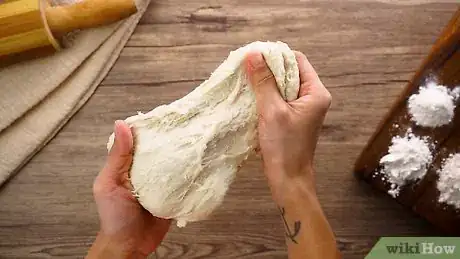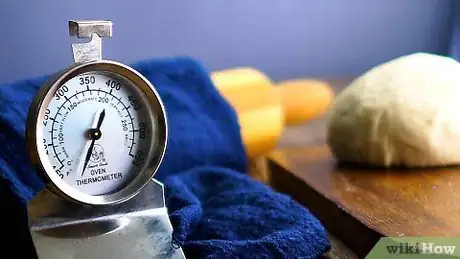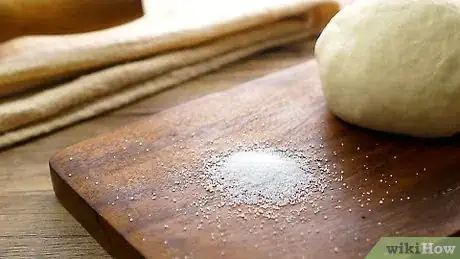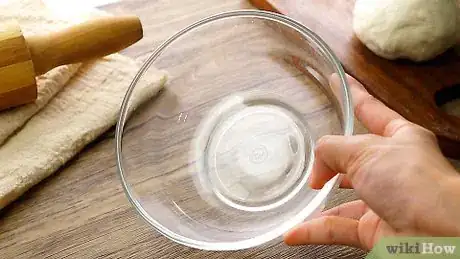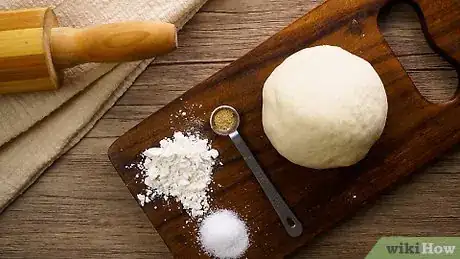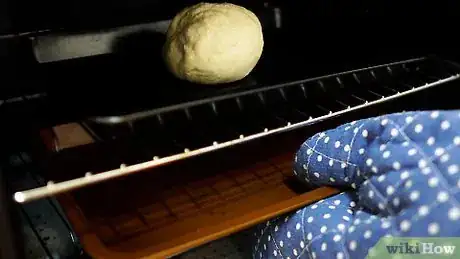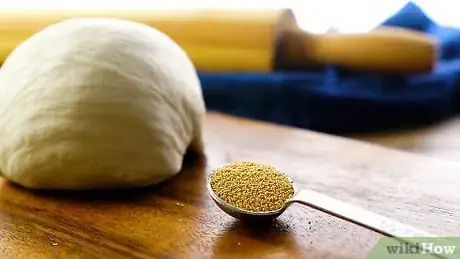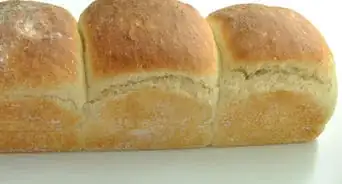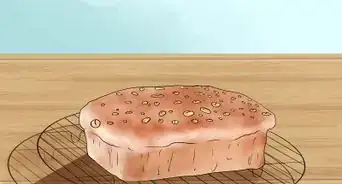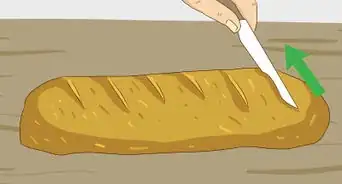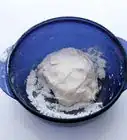This article was co-authored by Quynh La. Quynh La is a Professional Baker and the Owner of Sugar Bakery & Cafe in Seattle, Washington. With over seven years of experience, she specializes in baking cakes, cookies, croissants, and bread. Quynh holds an AAS in Culinary Arts from South Seattle College and a second AAS in Specialty Desserts & Bread from Seattle Central College.
There are 14 references cited in this article, which can be found at the bottom of the page.
wikiHow marks an article as reader-approved once it receives enough positive feedback. This article received 15 testimonials and 87% of readers who voted found it helpful, earning it our reader-approved status.
This article has been viewed 1,656,715 times.
You have it all planned: the dinner, the wine, that fresh-baked loaf of bread. Everything's coming together when you discover that your bread dough just isn't rising. Fortunately, this is a problem that's relatively easy to diagnose and solve. If your bread dough doesn't rise, you can still use it and fix it by changing up the temperature or mixing in more yeast.[1] Keep reading for instructions on how to revive your dough and learn the top reasons behind why dough won't rise.
Things You Should Know
- Let your dough proof at a high temperature (80–90°F or 27–32°C) and high humidity (about 75%) for at least 1 to 3 hours, as heat and moisture will make your dough rise faster.
- Add more yeast, blend in the starter, or knead in more flour to help initiate rising.
- Dough that has expired yeast, too much salt, all-purpose or cake flour, or antifungal spices like cinnamon might have trouble rising.
Steps
Why Isn’t My Bread Rising? The Top 7 Reasons
-
1Check your yeast type and expiration date. Unopened dry yeast lasts 2 years after the date it was packaged, while opened dry yeast lasts 4-6 months in the refrigerator or 6 months in the freezer.[2] After your yeast’s lifespan is up, it will function weakly, or not at all.[3]
- Some sourdough cultures are very slow rising and may need several hours to rise.
- If you’re following a no-knead recipe or making pizza dough, your bread will take longer to rise than if you’re using active dry or instant yeast.[4]
-
2Check the environment. The ideal temperature for bread baking is approx 75°F (24°C) with high humidity for a slow, steady, and flavorful rise.[5] Move too far below that range, and your yeast will not be happy.
- We’ll show you how to create a proof box to fix the temp and humidity in the next section.
Advertisement -
3Check the flour type and your kneading technique. Bread made with cake or all-purpose flour, has low gluten and protein contents, so your dough may rise—and then collapse.[6] To prevent your dough from collapsing, knead it for 15 minutes until it feels stiff, and use a high-protein flour in the future.[7]
- Dough can also collapse if you have too high of a flour-to-water ratio. Simple bread dough often has flour-to-water ratio of 5:3 (60% water).[8]
- Some flours contain antifungal ingredients to prolong shelf life. As yeast is a proud member of the Fungi kingdom, this will most definitely inhibit growth.
- Organic, additive-free unbleached white bread flour works best for a good loaf of white bread.
- Heavier flours such as whole wheat, rye and other types of whole-grain flour will result in a heavy loaf that does not rise as much as fine white bread flour.[9]
-
4Ease up on the salt. Salt is a required ingredient for developing the gluten proteins that make for a smooth elastic dough, but too much will kill the yeast.[10] Add only the required amount of salt, and add it to the flour, not the water, at the beginning.
-
5Use the proper container. The pan, banneton, or tray you use will make a difference. Too large, and the dough has nothing to push against when rising, so it won't rise upwards. Instead, it will spread and possibly collapse.[11]
- Small buns do well placed fairly close together.
-
6Make sure you’ve let the dough rest. Do not disturb the dough while it is rising, especially if it is a particularly wet dough. Most dough needs to rest 1-3 hours to get a proper rise.[12]
-
7Check your added ingredients. Some spices, such as cinnamon, are naturally antifungal. Those antifungal ingredients can kill your yeast![13]
- For sweet fruit buns or cinnamon rolls, you usually want a fast rise, as the cinnamon will eventually kill the yeast off.
- Some dried fruits also are coated with antifungals as a preservative. Organic dried fruits are expensive but much better for baking. What many bakers do is use standard dried fruit but don't add it till the final proofing.
Fixing Dough That Won't Rise
-
1Turn up the temperature to 80–90 °F (27–32 °C). Yeast loves nothing better than a warm, moist climate so it can multiply and your dough can proof.[14] If you want your dough to rise, up the temperature and set up the ideal humidity (75%) by creating a proof box in your oven.
- Fill a baking pan with boiling water, and set it on the lowest rack in your oven. Place the container of dough on the middle rack, and close the oven door and allow the dough to rise.
- Alternately, you can boil a cup of water in the microwave, then place the container of dough in the microwave with the water, and close the door. (Don't microwave the dough!)
- Some people turn on the oven, and place the dough on top of the stove, covered with a damp towel. The oven keeps the surface of the stove warm, and the damp towel provides the moisture.
-
2Add more yeast. If warm and moist isn't activating the yeast (you'll know in less than an hour), you can try adding more yeast.[15]
- Open a new package of yeast, and mix a teaspoon of yeast with 1 cup (240ml) of warm water (at about 110°F/43°C) and 1 tablespoon of sugar. Let this mixture proof for about 10 minutes, until it gets 1/2- to 1-inch of foam. If this fails, you will need to get fresh yeast and try again.
- While proofing this yeast mixture, gently warm the flat dough to about 75–90 °F (24–32 °C) by placing the bowl in a warm place.[16]
-
3Blend in the starter. Adding more flour as necessary: a ratio of 60% flour to 40% liquid is usually a good ratio for bread doughs so add sufficient flour needed to balance. Knead the active yeast mixture into the dough, then let it rise in a warm, moist place.
- This can also be an indicator to see if your yeast is not active. This method makes the yeast very active so when it is added to the dough, it should rise perfectly. If your dough still fails to rise, it will indicate the yeast is not at fault: there is another problem.
- You can also do this at the beginning of the recipe next time you make a different yeast dough.
-
4Knead in more flour. Check whether the dough is sticky to the touch. If so, this is probably under-kneaded dough. Knead in additional flour until smooth and silky to the touch and dough no longer sticks to your hand. Let rest and rise in a warm wet environment. Repeat if needed. You may need to let the dough rest overnight before shaping and baking.
-
5Knead the dough properly. There's an art to kneading. Too little, and you may not distribute the yeast through the dough. The dough will then be too weak to be able to rise. Too much kneading may make the dough so tough that it cannot expand. The dough should feel smooth and elastic, not tight like a rubber ball, or soft like biscuit dough.[17]
Community Q&A
-
QuestionIf I rolled the dough out, can I still put a damp cloth over the dough and let it rise?
 Community AnswerYe, you can. This is called proving the dough, that is, allowing it to rise after it has been shaped.
Community AnswerYe, you can. This is called proving the dough, that is, allowing it to rise after it has been shaped. -
QuestionWhat if I don't want my dough to rise?
 Community AnswerI found that putting it straight in the oven after kneading will keep it flat. Not keeping it warm will also keep it flat.
Community AnswerI found that putting it straight in the oven after kneading will keep it flat. Not keeping it warm will also keep it flat. -
QuestionMy dough is not smooth. What should I do?
 Zheng.lingdi 54Community AnswerYou may have over-kneaded the dough. Dough will go through a lumpy stage, sticky stage, elastic stage (perfect!) and finally a stiff, hard to manipulate stage where the surface looks broken. Like it has strings.
Zheng.lingdi 54Community AnswerYou may have over-kneaded the dough. Dough will go through a lumpy stage, sticky stage, elastic stage (perfect!) and finally a stiff, hard to manipulate stage where the surface looks broken. Like it has strings.
Warnings
- Should all repair attempts fail, you may need to change ingredients entirely and start again.⧼thumbs_response⧽
- Fixing yeast pastries can be very difficult in some cases, especially if layered with butter like puff pastries for yeast croissants. If you were to re-knead them, you will create a brioche-style dough which can be fine—but if you want that flaky characteristic, you will need to start again.⧼thumbs_response⧽
References
- ↑ https://www.bbcgoodfood.com/howto/guide/baking-sos-how-solve-10-common-bread-problems-luis-troyano
- ↑ http://www.eatbydate.com/other/baking/yeast/
- ↑ http://www.fauziaskitchenfun.com/dough-not-rising-find-out-why
- ↑ https://www.epicurious.com/ingredients/how-to-pick-the-right-yeast-for-the-job-article
- ↑ https://www.seriouseats.com/how-to-make-and-proof-bread-dough
- ↑ https://modernistcuisine.com/2018/04/gluten-how-does-it-work/
- ↑ https://www.theguardian.com/lifeandstyle/2006/jan/06/foodanddrink.features11
- ↑ https://www.smithsonianmag.com/arts-culture/ratio-based-bread-baking-58959921/
- ↑ https://www.tasteofhome.com/article/9-reasons-your-bread-isnt-rising-and-what-to-do-about-it/
- ↑ https://www.reluctantgourmet.com/salt-does-kill-yeast/
- ↑ https://www.tasteofhome.com/article/9-reasons-your-bread-isnt-rising-and-what-to-do-about-it/
- ↑ https://www.bbcgoodfood.com/howto/guide/6-steps-brilliant-bread
- ↑ https://microbiologysociety.org/news/society-news/could-cinnamon-oil-be-used-as-an-alternative-to-antifungals.html
- ↑ https://www.cooksillustrated.com/how_tos/6398-turning-your-oven-into-a-proof-box
- ↑ https://www.bbcgoodfood.com/howto/guide/baking-sos-how-solve-10-common-bread-problems-luis-troyano
- ↑ https://www.cooksillustrated.com/how_tos/6398-turning-your-oven-into-a-proof-box
- ↑ https://www.bonappetit.com/story/how-to-knead
About This Article
To fix dough that won’t rise, try placing the dough on the lowest rack in your oven along with a baking pan filled with boiling water. Close the oven door and let the dough rise. Increasing the temperature and moisture can help activate the yeast in the dough so it rises. You can also try adding more yeast. Open a new packet of yeast and mix 1 teaspoon (3 g) of it with 1 cup (240 mL) of warm water and 1 tablespoon (13 g) of sugar. Let the yeast mixture proof for 10 minutes. Then, add the mixture to your dough along with some more flour so there’s a ratio of 60% flour to 40% liquid. Knead the yeast mixture into the dough, then let the dough rise in a warm, moist place. Another option if your dough is flat and sticky to the touch is to knead in more flour. Keep kneading in flour until the dough is smooth and doesn’t stick to your hands, then let it rise somewhere warm and moist. Keep reading to learn more about why your dough might not be rising!
